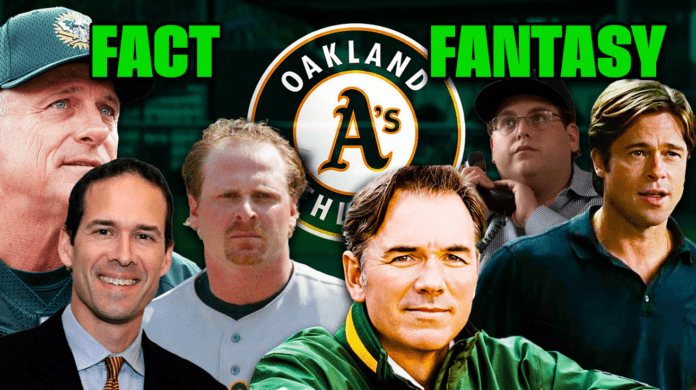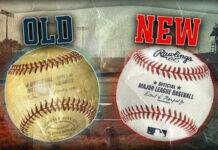
“Moneyball” burst onto screens in 2011 like a statistical revolution wrapped in Brad Pitt’s charisma, instantly transforming thousands of spreadsheet enthusiasts into armchair GMs. The film delivered an underdog triumph so perfectly crafted it might as well have been accompanied by swelling violins and slow-motion high fives. But as with most Hollywood “true stories,” the relationship between the film version and reality resembles a cat reluctantly sharing a bathtub with a rubber duck—technically possible, but creating discomfort for everyone involved.
Let’s dive into the fascinating gap between what actually happened and what screenwriters conjured up during their caffeine-fueled quest for dramatic tension.
11. The “Overnight Revolution” That Actually Took Years
The movie makes Oakland’s statistical revolution look like it happened faster than a TikTok trend. In reality? The A’s were grinding away at this approach since the Reagan administration. Sandy Alderson (remember him? Neither does the movie!) had been planting the seeds of data-driven baseball since the late ’80s, quietly rebuilding the organization while studio executives were still rocking shoulder pads.
The film compresses years of methodical change into a neat little package that fits between popcorn refills. It’s like claiming someone learned Italian overnight when they’ve actually been taking classes for a decade. Michael Lewis’s book acknowledged this gradual evolution, but Hollywood apparently found patience less entertaining than dramatic montages.
10. Baseball Scouts
According to the film, baseball scouts were essentially dinosaurs wearing polo shirts, utterly baffled by newfangled concepts like “numbers” and “logic.” They supposedly evaluated players using criteria like “good jawlines” and “makes nice sound with bat” – metrics about as scientific as a horoscope.
The truth? Many scouts were far more sophisticated than their cinematic counterparts. Sure, resistance to statistical methods existed (try introducing new tech to your grandparents if you want to experience this firsthand), but the film cranks the conflict dial to eleven. Real scouts assessed complex skills even when evaluating young Billy Beane himself. The movie’s version of scouting is about as accurate as claiming meteorologists just look up at the sky and guess.
9. The Man Behind “Peter Brand”
Jonah Hill’s “Peter Brand” (based on Paul DePodesta, who wisely refused to let them use his name) appears in the film as a freshly-minted Yale grad with all the confidence of a turtle on a tightrope. Beane supposedly discovers him like he’s a baseball Rain Man hidden in Cleveland’s accounting department.
In the shocking twist known as “reality,” DePodesta had already been working with Beane for THREE YEARS before the 2002 season. The Harvard economics grad (not Yale – Hollywood apparently can’t tell Ivy League schools apart) was an established baseball executive who had cut his teeth with the Cleveland Indians. Portraying him as a nervous newbie makes for better cinema but worse history. It’s like depicting LeBron James as someone who just discovered basketball last Tuesday.
8. Player Acquisitions
The movie actually gets some stuff right! David Justice, Chad Bradford, and Scott Hatteberg were indeed key acquisitions who exemplified Oakland’s “moneyball” approach of finding undervalued talent. Baseball traditionalists were genuinely skeptical about these players – Justice was supposedly washed up, Bradford threw like he was trying to high-five an ant, and Hatteberg was converting to first base after an injury (about as natural as teaching a cat to swim).
But that touching scene where Beane visits Hatteberg’s home to recruit him? Pure Hollywood fantasy, cooked up with the same historical accuracy as “Abraham Lincoln: Vampire Hunter.” The real negotiation happened over the phone. Less cinematic, perhaps, but considerably more efficient (and required fewer actors).
7. Jeremy Giambi
The film treats Jeremy Giambi (Jason’s brother, for those who don’t keep track of baseball siblings) like he just showed up in Oakland as part of Beane’s mid-season makeover. This timeline is about as accurate as claiming the iPhone was invented before the internet.
Truth bomb: Giambi had been with the A’s since 2000, almost two full seasons before the “Moneyball” year. His trade to Philadelphia had more complex factors behind it than the simplified “attitude problem” the movie suggests. The film rearranges Giambi’s Oakland timeline with the casual disregard of someone organizing their Netflix queue after a few margaritas.
6. Art Howe
Poor Art Howe. According to the film (where he’s played by Philip Seymour Hoffman with all the enthusiasm of someone waiting at the DMV), Howe was essentially baseball’s Darth Vader – the stubborn antagonist standing in the way of progress while sporting an outdated haircut.
Multiple interviews, including Howe’s own accounts, suggest he was actually supportive of the organization’s approach. The movie shows Beane doing everything short of filling out the lineup card and driving the team bus, roles that would have fallen squarely in Howe’s domain in real life. Hollywood needed a villain, and Howe drew the short straw. It’s like making a movie about the Wright brothers where one of them actively tries to sabotage the plane. (Great drama! Terrible history!)
5. Player Portrayals
The film’s portrayal of Athletics players ranges from “pretty close” to “did they even Google this person?” Carlos Pena and coach Ron Washington get reasonably faithful representations, which in a Hollywood sports movie is practically documentary-level accuracy.
Other players receive the standard Hollywood treatment – personalities amplified, stories simplified, and occasionally multiple real people blended into convenient composite characters. It’s like making a smoothie with whatever’s in the fridge – recognizable ingredients but definitely not how they naturally occur.
4. The Ricardo Rincon Trade
That edge-of-your-seat scene where Beane juggles phones like a circus performer to acquire Ricardo Rincon? About as authentic as a three-dollar bill. While Oakland did trade for Rincon in 2002, the high-tension phone dance never happened. Names were changed, separate deals combined, and dramatic tension manufactured faster than a reality TV producer can say “but what if we add sharks?”
The scene makes for riveting cinema but bears as much resemblance to actual MLB trade negotiations as “Top Gun” does to a typical day at flight school. Baseball executives rarely conduct business while dramatically slamming phones and staring intensely into the middle distance. (Though it would certainly make MLB Network more watchable if they did.)
3. Jeremy Brown’s Home Run
The movie presents catcher Jeremy Brown’s home run as a moment so profound it might as well have been accompanied by angels singing. In reality, Lewis’s book barely mentions this particular dinger. It’s like building a biopic around someone’s random Tuesday lunch order.
The emotional commentary about Brown “hitting like he was five-foot-six but thinking he was five-foot-one” was pure screenwriter poetry. Brown was certainly an important draft pick representing Oakland’s against-the-grain philosophy, but the film turns his home run into the baseball equivalent of the moon landing. Dramatic? Yes. Factual? About as much as claiming the Titanic had a minor plumbing issue.
2. The Invisible Stars
Here’s where the movie pulls its most spectacular vanishing act since “Now You See Me.” The 2002 Athletics featured AL MVP Miguel Tejada, Cy Young winner Barry Zito, and pitchers Tim Hudson and Mark Mulder – a collection of talent that gets about as much screen time as vegetable platters at a kids’ birthday party.
This omission creates the impression that Oakland’s 103 wins came entirely from rescuing baseball’s island of misfit toys. It’s like making a movie about NASA and focusing exclusively on the janitors (who, while important, weren’t personally piloting the rockets). The Moneyball approach absolutely contributed to the team’s success, but pretending these stars didn’t exist is like crediting Microsoft’s success to their excellent cafeteria food.
1. The Strategy Reality Check
The A’s approach wasn’t about completely abandoning star power – it was about supplementing it efficiently when you couldn’t afford to buy a team of all-stars like the Yankees (who were basically running baseball’s equivalent of using cheat codes in a video game).
Oakland’s success came from blending analytically identified role players with traditionally scouted stars – a nuance that gets lost faster than socks in a dryer. The strategy wasn’t revolutionary because it rejected traditional evaluation but because it identified market inefficiencies to build affordable depth. It’s like being good at finding designer clothes at thrift shops – you still appreciate Gucci, you just found a smarter way to get dressed.


